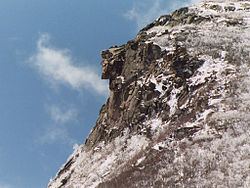Elevation 960 m | ||
 | ||
Similar Cannon Mountain, Mount Lafayette, Mount Washington, Mount Lincoln, Little Haystack Mountain | ||
Old man of the mountain nh story collapse current state
The Old Man of the Mountain, also known as the Great Stone Face or the Profile, was a series of five granite cliff ledges on Cannon Mountain in the White Mountains of New Hampshire, United States, that appeared to be the jagged profile of a face when viewed from the north. The rock formation was 1,200 feet (370 m) above Profile Lake, and measured 40 feet (12 m) tall and 25 feet (7.6 m) wide. The site is located in the town of Franconia.
Contents
- Old man of the mountain nh story collapse current state
- Map of Old Man of the Mountain Franconia NH 03580 USA
- Old man of the mountain collapse anniversary
- History
- Collapse
- After collapse
- Timeline of the Old Man
- References
Map of Old Man of the Mountain, Franconia, NH 03580, USA
The first recorded mention of the Old Man was in 1805. It collapsed on May 3, 2003.
Old man of the mountain collapse anniversary
History
The formation was carved by glaciers and was first recorded as being discovered by a surveying team around 1805. The official state history says several groups of surveyors were working in the Franconia Notch area at the time and claimed credit for the discovery.
The Old Man was famous largely because of statesman Daniel Webster, a New Hampshire native, who once wrote: "Men hang out their signs indicative of their respective trades; shoe makers hang out a gigantic shoe; jewelers a monster watch, and the dentist hangs out a gold tooth; but up in the Mountains of New Hampshire, God Almighty has hung out a sign to show that there He makes men."
The writer Nathaniel Hawthorne used the Old Man as inspiration for his short story "The Great Stone Face", published in 1850, in which he described the formation as "a work of Nature in her mood of majestic playfulness".
The profile has been New Hampshire's state emblem since 1945. It was put on the state's license plate, state route signs, and on the back of New Hampshire's Statehood Quarter, which is popularly promoted as the only US coin with a profile on both sides. Before the collapse, it could be seen from special viewing areas along Interstate 93 in Franconia Notch State Park, approximately 80 miles (130 km) north of the state's capital, Concord.
Collapse
Freezing and thawing opened fissures in the Old Man's forehead. By the 1920s, the crack was wide enough to be mended with chains, and in 1957 the state legislature passed a $25,000 appropriation for a more elaborate weatherproofing, using 20 tons of fast-drying cement, plastic covering, and steel rods and turnbuckles, plus a concrete gutter to divert runoff from above. A team from the state highway and park divisions maintained the patchwork each summer.
Nevertheless, the formation collapsed to the ground between midnight and 2 a.m., May 3, 2003. Dismay over the collapse was so great that people left flowers at the base of the cliffs in tribute.
After collapse
Early after the collapse, many New Hampshire citizens considered replacement with a replica. That idea was rejected by an official task force in 2003 headed by former Governor Steve Merrill.
In 2004, the state legislature considered, but did not accept, a proposal to change New Hampshire's state flag to include the profile.
On the first anniversary of the collapse in May 2004, the Old Man of the Mountain Legacy Fund (OMMLF) began operating coin-operated viewfinders near the base of the cliff. When looking through them up at the cliff of Cannon Mountain one can see a "before" and "after" of how the Old Man of the Mountain used to appear.
Seven years after the collapse, on June 24, 2010, the OMMLF, now the Friends of the Old Man of the Mountain, broke ground for the first phase of the state-sanctioned "Old Man of the Mountain Memorial" on a walkway along Profile Lake below Cannon Cliff. It consists of a viewing platform with "Steel Profilers", which, when aligned with the Cannon Cliff above, create what the profile looked like up on the cliff overlooking the Franconia Notch. The project was overseen by Friends of the Old Man of the Mountain/Franconia Notch, a committee that succeeded the Old Man of the Mountain Revitalization Task Force. The Legacy Fund is a private 501(c)(3) corporation with representatives from various state agencies and several private nonprofits.
In 2013, the board called a halt to further fundraising. They announced their intention to spend what was left on minor improvements and dissolve the board.
Other proposals that were considered but rejected include:
Timeline of the Old Man
Details of the history of the Old Man of the Mountain include:
